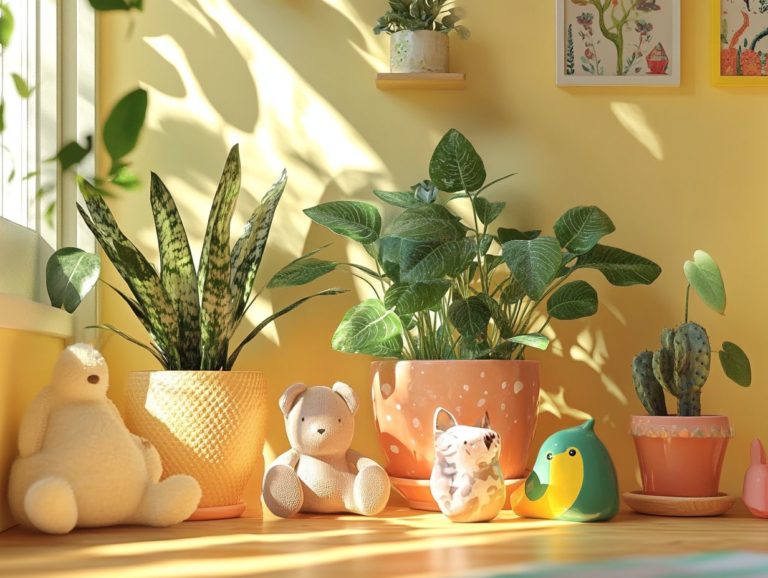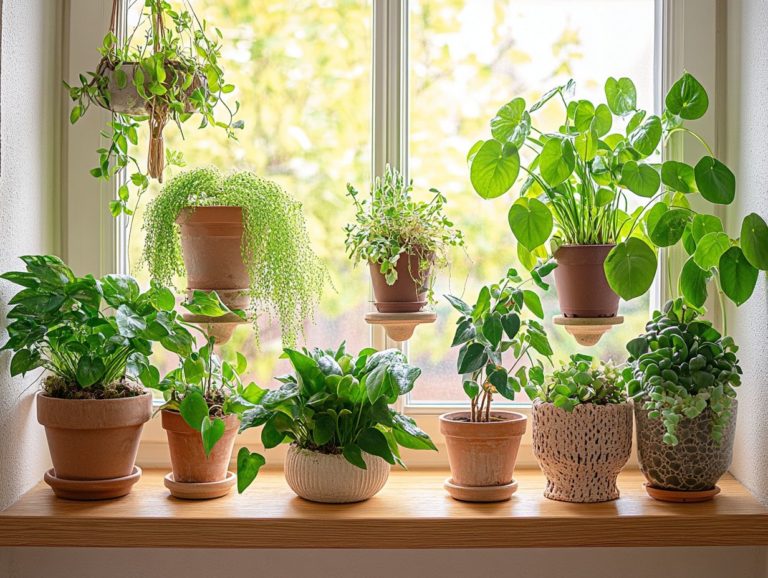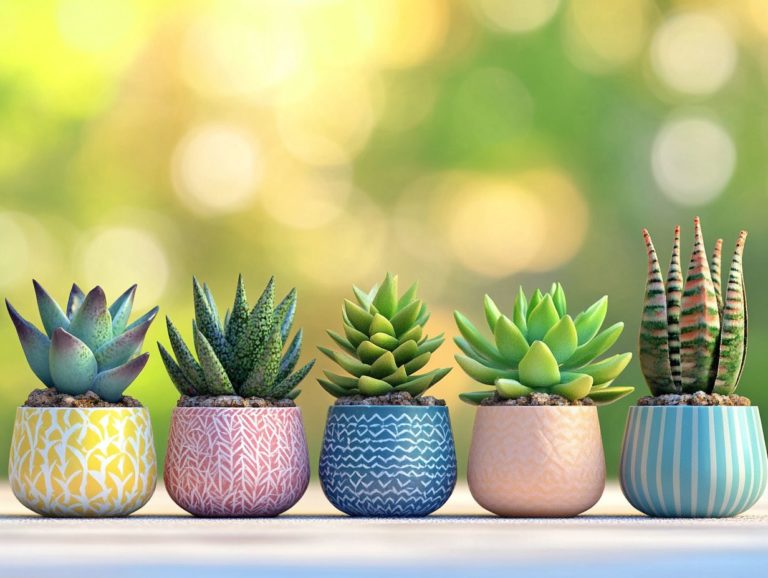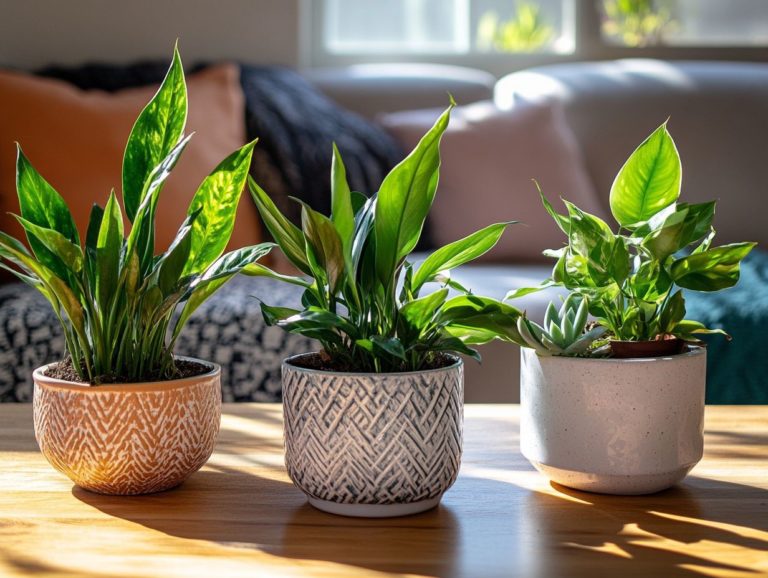The Best Indoor Vines for Small Spaces
Transforming small spaces into vibrant green retreats is easier than you might think, especially with the right indoor vines and houseplants at your fingertips.
From the lush Pothos to the striking Monstera Deliciosa, you ll discover 15 captivating options that not only enhance your home s aesthetic but also purify the air you breathe. These plants are ideal for indoor settings.
You ll receive guidance on selecting the perfect vine for your unique space. You ll also find care tips to ensure they flourish. Plus, you ll find creative decorating ideas to elevate your indoor garden.
Don t worry you’ll also learn about common pitfalls to avoid on your indoor gardening journey. Get ready to transform your space into a green paradise!
Contents
- Key Takeaways:
- 1. Discover Pothos: Your Low-Maintenance Marvel!
- 2. English Ivy: The Timeless Climber!
- 3. Spider Plant: The Air-Purifying Beauty!
- 4. Philodendron
- 5. String of Pearls
- 6. Heartleaf Philodendron
- 7. Chinese Money Plant
- 8. Golden Pothos
- 9. Hoya
- 10. Monstera Deliciosa
- 11. Arrowhead Plant
- 12. Boston Fern
- 13. Grape Ivy
- 14. Wandering Jew
- 15. Devil’s Ivy
- Frequently Asked Questions
Key Takeaways:
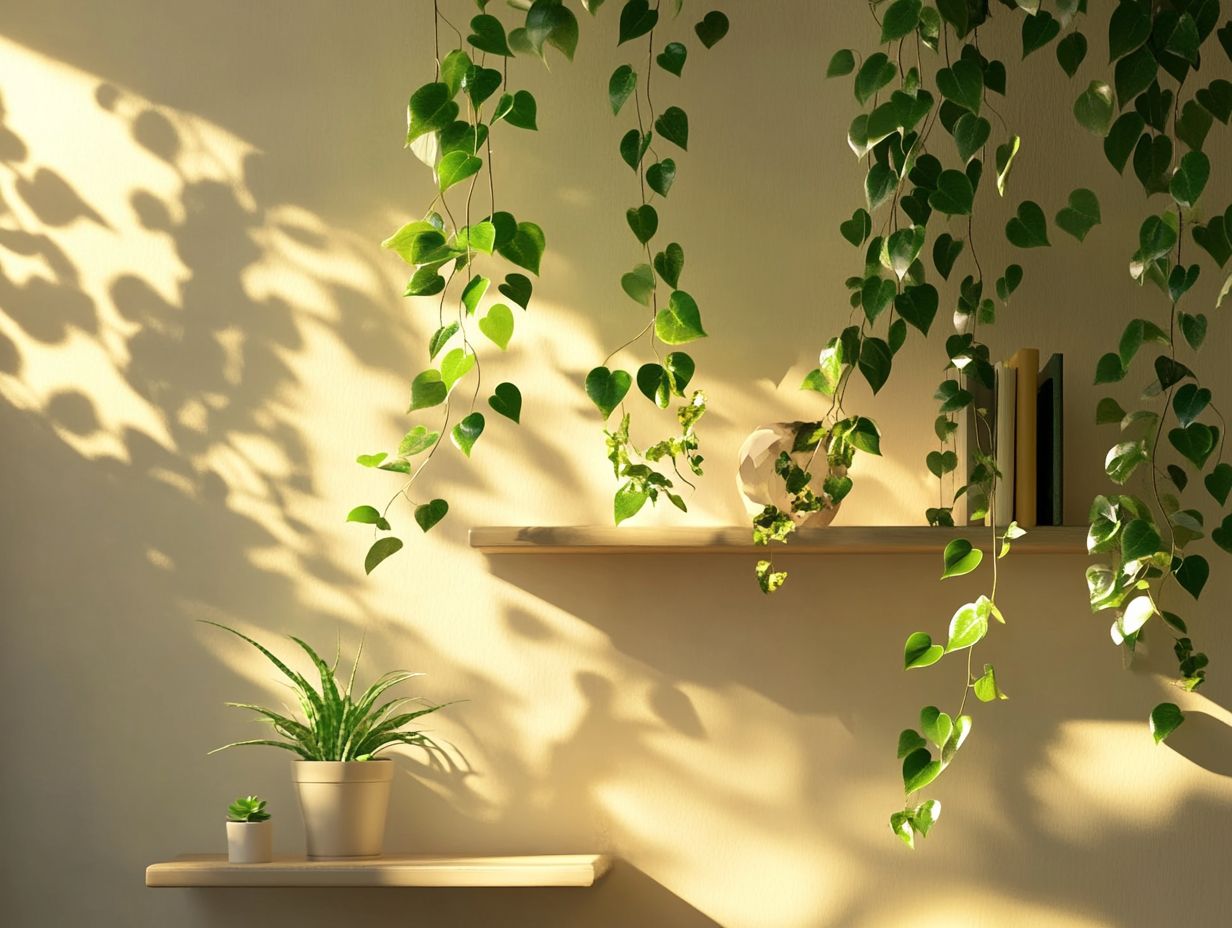
- Pothos is your go-to plant, needing little fuss while thriving beautifully!
- English Ivy adds a cheerful touch of elegance to any small space with its classic charm.
- Spider Plant purifies the air while adding a vibrant pop of greenery to your home.
1. Discover Pothos: Your Low-Maintenance Marvel!
Pothos is often hailed as one of the easiest houseplants to grow. It flaunts stylish, vibrant foliage that thrives under various indoor conditions and light. This makes it essential for both novices and seasoned indoor gardening aficionados alike.
This resilient plant flourishes in very bright light and remains perfectly content even in less-than-ideal situations. Its minimal watering needs mean you should let the soil dry out between waterings to avoid the common pitfall of overwatering. Humidity levels, or the amount of moisture in the air, aren’t a major concern; Pothos adapts well to diverse environments. Occasional misting can help keep its leaves looking glossy.
When potting, use a well-draining soil mixture to promote vibrant growth. Don t shy away from pruning; it helps maintain a bushy appearance while encouraging vibrant growth. Beyond its practicality, the cascading vines of Pothos and other climbing plants effortlessly infuse any space with lush greenery, bringing a delightful touch of nature indoors.
2. English Ivy: The Timeless Climber!
English Ivy stands out as a beloved choice for indoor gardening enthusiasts. It showcases its climbing prowess and timeless aesthetic that can enhance your home decor all while demanding minimal upkeep.
To truly thrive, this adaptable plant favors bright, indirect sunlight, which keeps its leaves vibrant and healthy for optimal growth. While it can manage in lower light, you may notice its growth slows down, leading to less robust vines and less vibrant foliage.
Maintaining the right humidity levels is essential, as English Ivy flourishes in moist environments. Mist the leaves or strategically place a humidifier nearby to significantly improve its well-being, enhancing the atmosphere around the plant.
For watering, consistency is key. Allow the top inch of soil to dry out between waterings to prevent root rot, promoting healthy plants. Pruning your English Ivy not only fosters a fuller appearance but also encourages fresh growth, turning care into a gratifying endeavor.
3. Spider Plant: The Air-Purifying Beauty!
The Spider Plant is an indoor gem, renowned for its remarkable ability to flourish in varied light conditions while purifying the air. It makes a chic and low-maintenance enhancement to your home decor.
This delightful plant features long, arching leaves that gracefully spill over the edges of its pot. This creates a stunning cascading effect that adds character to any space, showcasing its unique textures. It even produces charming baby plantlets, affectionately known as ‘pups,’ which you can propagate to grow your collection or share with friends.
To keep your Spider Plant thriving, focus on using well-draining potting soil and only water it when the topsoil feels dry. This simple routine ensures its health and vitality.
Beyond its aesthetic charm, the Spider Plant plays a significant role in fostering a healthier indoor environment by filtering out common pollutants. It enhances air quality and promotes a tranquil living space that enriches your home.
4. Philodendron
Philodendrons are a versatile choice in indoor gardening, offering captivating varieties that showcase unique shapes and vibrant foliage. They effortlessly infuse your space with tropical charm and require minimal care to thrive.
Among these delightful options, the Heartleaf Philodendron shines with its stunning trailing vines, making it perfect for hanging baskets or stylish shelves. The Velvet Leaf captivates with its rich texture, thriving in bright, indirect light and well-draining soil an exquisite addition to any collection.
If you’re keen on enhancing vertical spaces, the Climbing Philodendron is eager to ascend a trellis or moss pole, transforming any corner into a lush oasis.
To keep your philodendrons flourishing, maintain humidity levels between 50-70%. Regular misting provides the moisture they need, ensuring their foliage remains vibrant.
5. String of Pearls
The String of Pearls stands out as a captivating succulent, with its cascading, bead-like leaves making it a delightful addition to your indoor garden, whether you’re a novice or a seasoned pro.
To keep this charming plant thriving, prioritize well-draining soil, ideally a cactus mix that allows moisture to escape easily. Water with a light touch, typically every two to three weeks, ensuring the soil dries out completely between waterings to avoid root rot.
This succulent flourishes in bright, indirect light, so position it near a sunny window to encourage robust growth. For an eye-catching display, try using a hanging planter or an open-sided container, allowing the trailing vines to cascade gracefully.
6. Heartleaf Philodendron
The Heartleaf Philodendron is a captivating indoor plant that thrives in low-light conditions. It’s the perfect choice for anyone seeking an easy-care houseplant with stunning heart-shaped leaves and vibrant colors.
Water moderately; let the top inch of the soil dry out between waterings to stave off root rot and promote healthy growth. It flourishes best in a well-draining potting mix, which retains some moisture while remaining airy.
Prune these trailing vines to encourage bushier growth and open up creative possibilities. Let those long vines cascade over shelves or fashion an eye-catching trellis display, enhancing your indoor decor. This versatility turns the Heartleaf Philodendron into not just a low-maintenance plant; it s a decorative gem that elevates any indoor space.
7. Chinese Money Plant
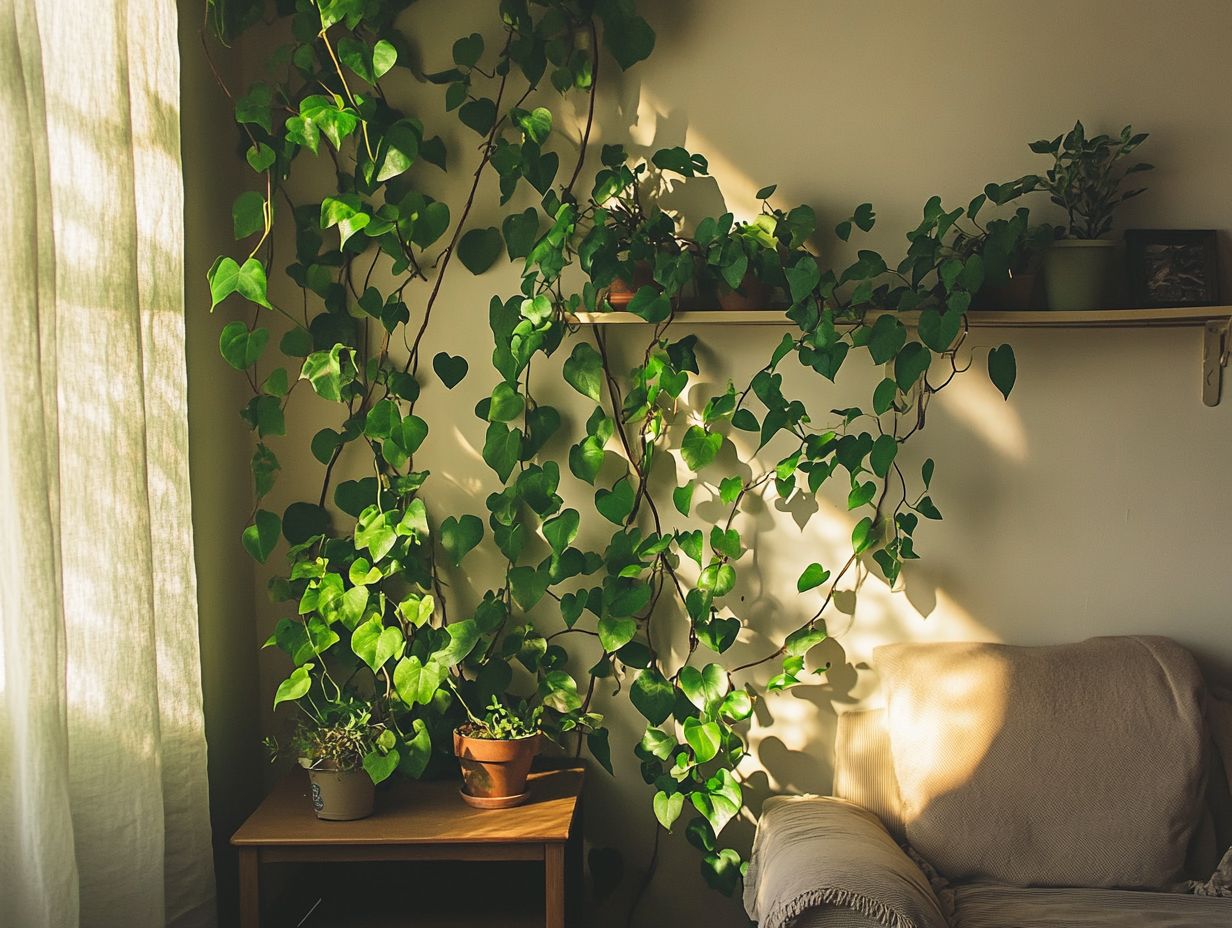
The Chinese Money Plant, with its charming round leaves, is more than just a stylish addition to your indoor space; it symbolizes prosperity and good fortune, making it a favorite among indoor gardening enthusiasts. Join many indoor gardening enthusiasts who love this plant for its beauty and symbolism!
Ensure it receives bright, indirect light this makes it an ideal companion for a well-lit room or a spot near a window with filtered sunlight, promoting vibrant growth. Water thoroughly when the top inch of soil feels dry, but be cautious; overwatering can lead to root rot.
Maintaining a humidity level that mirrors its natural habitat is key to its overall health. Occasionally mist the leaves or place the pot on a humidity tray to enhance the plant’s beauty. Showcasing the Chinese Money Plant on a pedestal or shelf allows its cascading leaves to drape gracefully, creating an inviting focal point in any room.
Don’t miss out on adding this beauty to your collection today!
8. Golden Pothos
Transform your indoor space with the Golden Pothos! This stunning plant showcases vibrant golden leaves that effortlessly brighten up your home and enhance your decor. Not only is it beautiful, but it’s also incredibly easy to care for, making it perfect for gardeners of any skill level.
To ensure this climbing beauty flourishes, provide it with bright, indirect sunlight to promote healthy growth. While it can adapt to lower light conditions, remember to keep it out of direct sunlight, as that can damage those delicate leaves. For watering, maintain consistent moisture, allowing the soil to dry out slightly between waterings to avoid root rot and ensure the plant thrives.
Thanks to its natural tendency to trail or climb, the Golden Pothos makes an excellent addition to bookcases or hanging pots. It adds height and vitality to your decor while creating lush, green displays that are sure to impress your guests.
9. Hoya
Elevate your decor with the breathtaking Hoya plant! With its waxy leaves and stunning blooms, this beloved indoor plant thrives in bright light, enhancing the aesthetic of your indoor gardening collection.
To ensure this tropical gem prefers a sunny spot, position it where it can bask in bright, indirect sunlight. Be mindful to avoid harsh, direct rays, as they can damage its delicate foliage.
This tropical beauty loves humidity, ideally between 40-60%, meaning the amount of moisture in the air. You can easily achieve this with a pebble tray or by misting its leaves occasionally, creating an attractive indoor atmosphere.
For an eye-catching display, consider placing the Hoya in hanging planters or training it to climb along a trellis. This not only enhances its visual charm but also allows its lovely trailing vines to cascade beautifully, transforming your space into a lush indoor oasis.
10. Monstera Deliciosa
The Monstera Deliciosa, often known as the Swiss Cheese Plant, is truly a showstopper! Its large, distinctive leaves effortlessly infuse any indoor space with a hint of tropical elegance, all while being surprisingly easy to care for.
To ensure this stunning plant thrives, it craves bright, indirect light and appreciates the occasional splash of direct sunlight, which enhances its unique leaf patterns. For watering, a balanced approach is essential allow the top inch of soil to dry out between waterings. Be mindful not to overwater, as that can lead to root rot. Aim for a humidity level around 60%; misting the leaves or placing the pot on a humidity tray can work wonders.
The distinctive foliage of Monstera Deliciosa can blend into various decor styles, from bohemian vibes to modern minimalism, serving as a vibrant focal point that enhances the overall aesthetic of any room. Don’t miss out on adding this stunning beauty to your home!
11. Arrowhead Plant
The Arrowhead Plant is a delightful addition to your indoor garden! Known for its distinctive arrow-shaped leaves, it can grow in different light types, making it an ideal choice for low-maintenance plant lovers.
Whether you place it in bright, indirect sunlight or in partially shaded areas, the Arrowhead Plant can thrive effortlessly. Just remember to steer clear of direct sunlight, as it can scorch those beautiful leaves.
For watering, you’ll find that this plant enjoys a warm environment but thrives with a balanced approach. Allowing the top inch of soil to dry out between waterings encourages healthy growth, while over-watering can lead to root rot. To enhance its lush and vibrant foliage, consider regular misting to boost humidity, promoting that robust, bushy appearance you desire.
12. Boston Fern
Bring home the elegance of the Boston Fern! Celebrated for its lush foliage and remarkable air-purifying abilities, it thrives in humid environments, making it an excellent choice for elevating your indoor atmosphere naturally.
To ensure this fern flourishes, keep the soil consistently moist, so regular watering is essential just be careful not to let it become soggy. It does best in indirect sunlight; too much direct exposure can scorch its delicate leaves, while insufficient light may stunt its growth.
Maintaining humidity levels around 60-80% is crucial, as this mimics its native tropical habitat. Not only does this plant bring a refreshing touch to any indoor space, but it also effectively filters toxins from the air, creating a healthier environment for everyone in your home.
13. Grape Ivy
Grape Ivy, with its enchanting climbing nature and ornamental allure, stands as a superb choice for those who wish to infuse their indoor spaces with lush greenery and a dash of whimsy.
To truly flourish, this striking plant craves bright, indirect light. It is perfectly suited for well-lit areas such as your living room or sunroom. Water regularly, but let the top inch of soil dry out between waterings. This prevents too much water from harming the plant. Pruning is also recommended; it encourages bushier growth and keeps the vines in check, enhancing its aesthetic versatility.
Imagine Grape Ivy gracefully cascading down your shelves or being trained up trellises, effortlessly elevating your indoor environment with its vibrant foliage and refreshing charm.
14. Wandering Jew
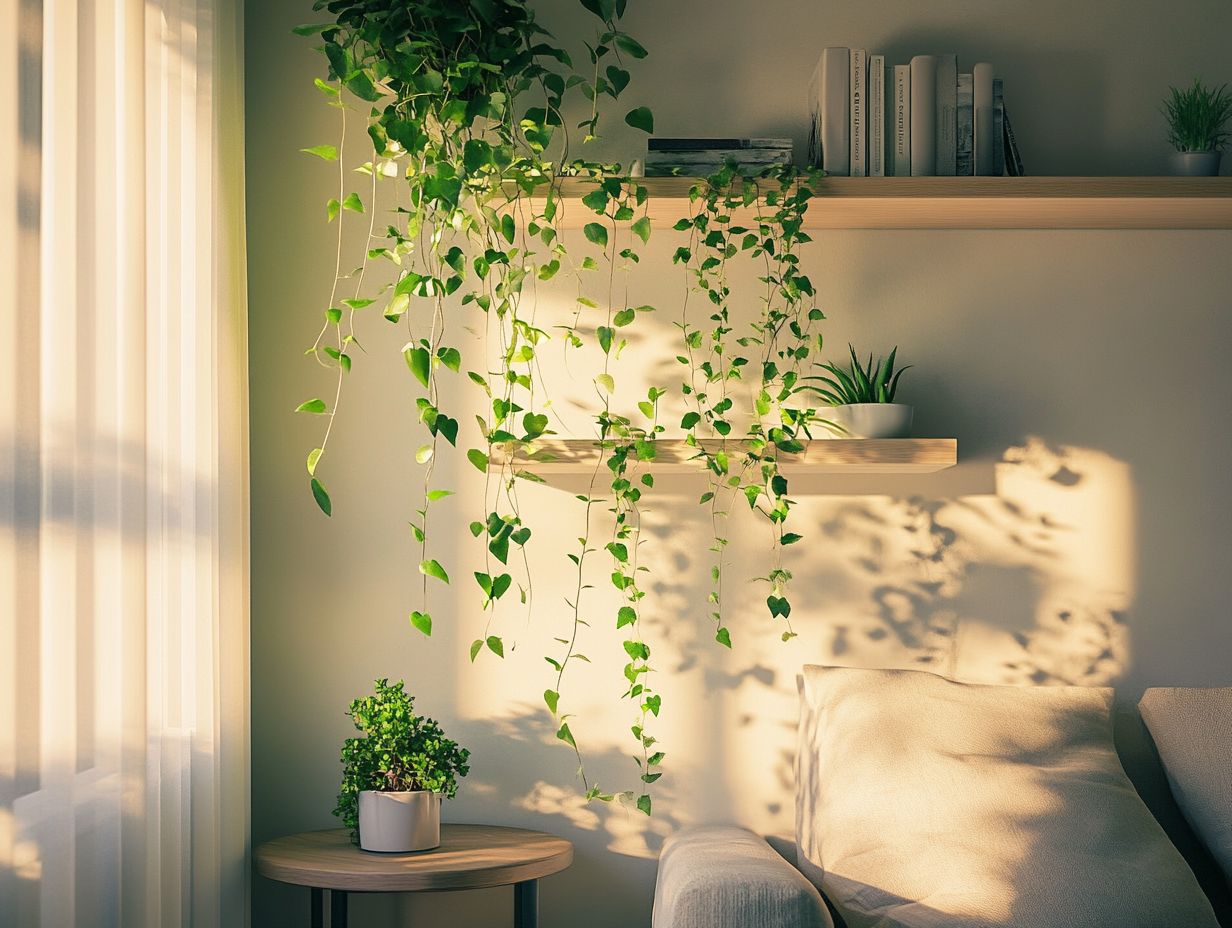
The Wandering Jew bursts with bold hues and unique leaf patterns, bringing nature into your home while enhancing your decor! This stunning indoor plant effortlessly captures attention with its vibrant colors and cascading growth, making it a striking addition to any indoor environment while remaining relatively low-maintenance.
To truly thrive, this plant loves bright, indirect sunlight, which brings out its colorful foliage, showcasing a beautiful blend of green, purple, and silver. Watering should be just right; allowing the top inch of soil to dry out between waterings will encourage healthy growth. By keeping the warmth and humidity levels in check, you ll create the perfect atmosphere for this beauty.
With its bold hues and distinctive leaf patterns, the Wandering Jew not only infuses your space with a touch of nature but also complements various decor styles, transforming an ordinary room into a vibrant sanctuary.
15. Devil’s Ivy
Devil’s Ivy, also known as Pothos, is a resilient indoor plant that s truly remarkable for its ability to thrive in low-light conditions. This makes it a go-to choice for beginner gardeners who desire low-maintenance greenery adorned with stunning leaf patterns.
With its striking heart-shaped leaves and cascading vines, this plant easily adapts to various indoor settings, infusing every room with a touch of lushness. Its climbing nature lets it cascade down shelves or climb trellises gracefully, opening up a world of creative styling possibilities.
Devil’s Ivy thrives in indirect sunlight, ensuring that its vibrant colors stay vivid without the risk of scorching. Remember to water it occasionally, especially when the top inch of soil feels dry. Follow this simple routine to keep your Devil’s Ivy thriving and brighten any space today!
How to Choose the Right Indoor Vine for Your Space?
Choosing the perfect indoor vine for your space means considering factors like light availability, humidity levels, and your personal aesthetic preferences. Choose plants that thrive in your space and enhance your decor.
Take the pothos vine, for example. It’s an outstanding choice for beginners, as it easily adapts to low-light conditions and requires just occasional watering ideal for those who may not consider themselves plant whisperers.
If you want to try something different, the string of hearts thrives in bright, indirect light and craves a touch more humidity. Its beautifully trailing effect can instantly liven up a shelf or hanging planter.
When selecting indoor vines, consider the space they’ll inhabit. Are you leaning toward a lush, cascading look, or do you prefer something more minimalistic? A philodendron, with its heart-shaped leaves, can add a touch of elegance while remaining easy to care for making it a fantastic choice for both novice and seasoned plant enthusiasts.
Start exploring your options today and bring new life to your indoor spaces!
What Are the Best Ways to Care for Indoor Vines?
Caring for your indoor vines effectively means grasping their unique watering needs, light requirements, and humidity preferences. This understanding allows them to thrive and retain their vibrant charm over time.
To cultivate the ideal environment for these plants, it s essential to familiarize yourself with the different light conditions they flourish in, from bright indirect sunlight to cozy low-light corners. Regularly checking the soil moisture is key; typically, you ll want to wait until the top inch dries out before watering again, as overwatering can lead to root rot.
Maintaining the right humidity levels is crucial for promoting growth. Using a humidifier can greatly help your plants thrive. You might also create a more hospitable atmosphere by placing a pebble tray filled with water nearby. A pebble tray is a shallow dish filled with pebbles and water to increase humidity around your plants.
Choosing the right potting mix is also vital; opt for well-draining soil to prevent excess moisture buildup. Don t forget to repot them occasionally this little boost can stimulate growth and ensure their roots have plenty of room to expand.
How Can Indoor Vines Be Used to Decorate Small Spaces?
Indoor vines can truly transform your small space, infusing it with lush greenery and life. With a bit of creativity in your displays, you can maximize vertical space and elevate the overall ambiance of the room.
Consider utilizing hanging options like macram plant hangers or ceiling-mounted hooks to draw the eye upward. This clever trick creates the illusion of height and spaciousness, making your space feel more expansive.
Wall-mounted displays, such as trellises or floating shelves, serve as the perfect backdrop for trailing vines. This allows for easy customization to suit your style.
Don t overlook container arrangements, either. Stylish wall planters or corner shelves can make a significant impact on optimizing space. Regarding aesthetics, think about selecting vibrant green varieties or incorporating colorful pots. This thoughtful approach ties everything together, ensuring that each element complements the other and creates a harmonious environment.
What Are Some Common Mistakes to Avoid When Growing Indoor Vines?
When you embark on the journey of growing indoor vines, it s crucial to steer clear of common missteps like overwatering, neglecting light requirements, and inadequate pruning. These pitfalls can seriously impede their growth and overall health.
To cultivate your vines successfully, pay close attention to your watering habits. Aim for a balanced approach allowing the soil to dry slightly between waterings promotes healthy root development. Understanding that different vines have distinct light needs is equally vital; positioning them near bright, indirect sunlight can substantially enhance their vitality.
Embracing proper pruning techniques will encourage bushier growth and prevent overcrowding. This ensures that each vine thrives without competing for resources. By adopting these practices, you can transform your indoor space into a green space filled with vibrant greenery, especially by using the top 10 indoor plants for small spaces.
How Can Indoor Vines Improve Air Quality in a Small Space?
Indoor vines not only elevate the beauty of your small spaces but also are important in improving air quality. Many varieties are quite adept at filtering toxins and producing oxygen, resulting in a healthier indoor environment.
Among the most popular choices, pothos and philodendrons truly shine with their remarkable capability to eliminate harmful substances like formaldehyde and xylene from the air. These easy-to-care-for vines are perfect for anyone new to plant care, thriving in indirect light and requiring minimal care.
To fully harness their benefits, consider placing them in areas with limited air circulation, such as near windows or in corners. This placement allows their air-purifying powers to make a significant impact. Incorporating decorative trellises can amplify their visual appeal, infusing your space with a touch of nature that fosters a more uplifting atmosphere while simultaneously promoting well-being. The cascading leaves of climbing vines can further enhance your indoor decor. For those in small spaces, exploring the top 5 indoor plants for small apartments can be a great way to maximize your greenery.
Frequently Asked Questions
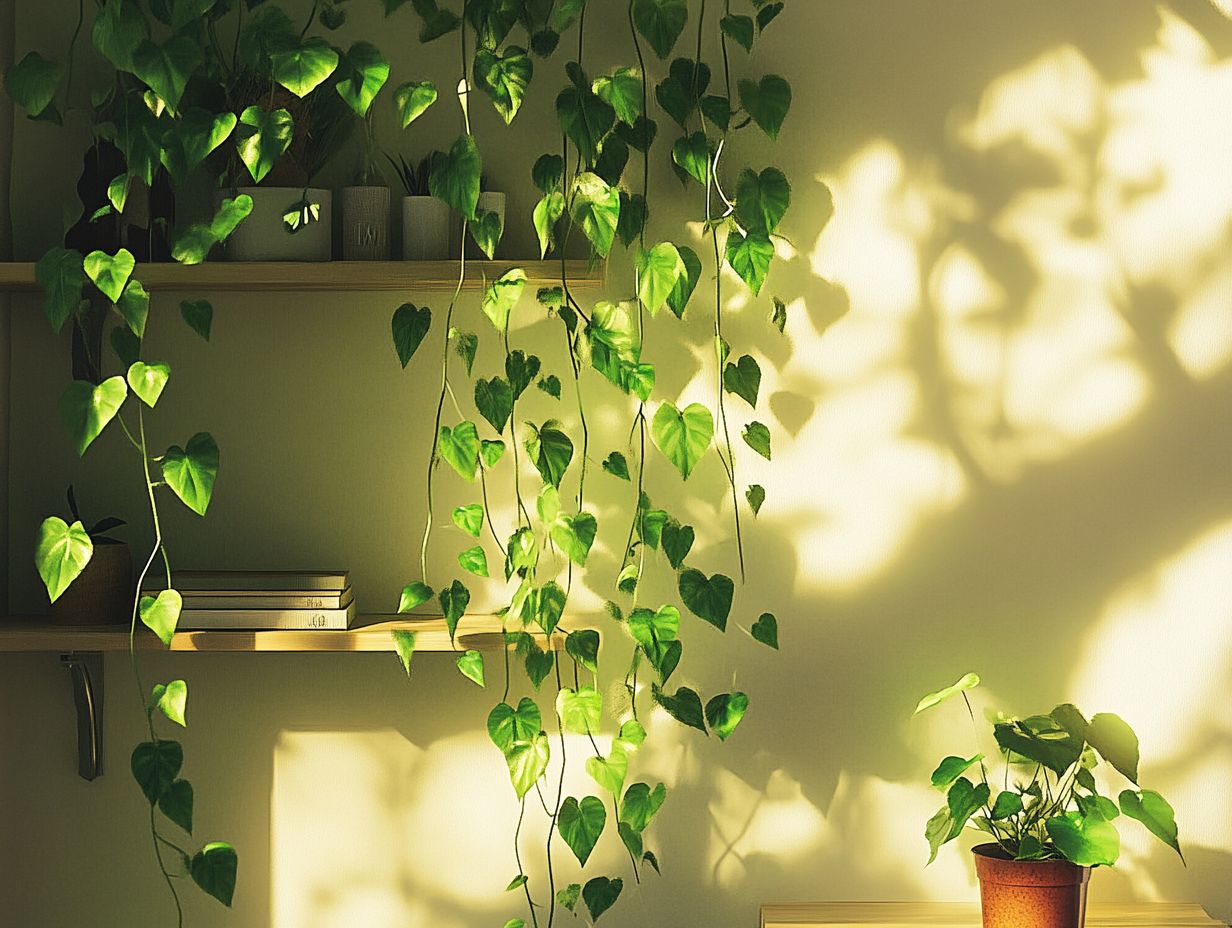
Start your indoor vine journey today and watch your space transform!
What are the best indoor vines for small spaces and houseplants?
Popular options for small spaces include Pothos, Philodendron, Ivy, spider plant, and heartleaf philodendron. These low-maintenance plants thrive indoors, making them perfect for your gardening adventures.
Can indoor vines grow in low light and humidity?
Yes! Many indoor vines flourish in low light. Pothos, Ivy, and heartleaf philodendron can handle different humidity levels with ease.
Do indoor vines need a lot of water?
It varies by plant, but most indoor vines only need watering about once a week. Be careful not to overwater; let the soil dry out to keep your plants healthy!
What is the best way to care for indoor vines?
Caring for indoor vines is simple but important. Regular watering, occasional pruning, and ensuring they receive enough light will help your vines thrive.
Which indoor vines are best for hanging baskets?
Vines like Pothos, Philodendron, and Ivy are fantastic for hanging baskets. Their long, trailing stems create a beautiful cascade, adding cheerful colors to your home.
Can indoor vines help purify the air in small spaces?
Absolutely! Many indoor vines can purify the air, improving the atmosphere in small areas. Pothos, spider plant, and Philodendron are excellent choices for removing toxins and enhancing your home.

